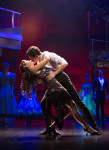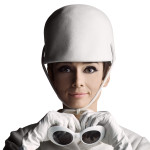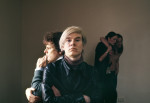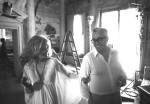Dear Reader of LeonardoVfashionbook, we are delighted to introduce you to Douglas Kirkland. We are in his beautiful garden in Hollywood; splashes of bright sunlight and smiling surrounds us and the only woman figure, who appears like a fairy tale is Françoise, his wife and unbelievable partner for life. Their son Mark Kirkland, whom we did not have the pleasure to meet, is the director of the famous TV cartoon series ‚‘ The Simpsons‘‘.
Douglas Kirkland, the Greatest Photographer of all Times, and the Immortal Marilyn Monroe
July 22, 2014, 10:00 By Leonardo Vecchiarelli and Dennis Bornheim
Douglas is unquestionably the humblest person I’ve ever met in my life, rich of values and sense of responsibility for all that surrounds him, and for human beings in particular. He lives in the essence of life and through his own experience he makes us live in a dream world as one of history‘s most influential Photographer. Let us just think of the iconic images from the great masters of photography: “The Kiss” by Robert Doisneau, for example, or Robert Capa’s photo of a falling soldier during the Spanish Civil War. Not to mention Henri Cartier-Bresson’s brilliant captures of the ”decisive moment”. Yet we usually know very little about the lives of the artists who created these photographs and left their imprint on the minds of millions of people around the world. Douglas Kirkland is undoubtedly one of these masters; with his immortal moments with Marilyn Monroe and many other celebrities he turned photography into something more than just the mere representation of a particular moment or situation. He loves people and all aspects of the society around him. Douglas made his debut in the art world with “Film stills”, showing himself in different situations resembling scenes from famous movies such as Titanic, Out of Africa, Australia….He photographed artists such as Charlie Chaplin and Marilyn Monroe, Andy Warhol and Angelina Jolie; he travelled the world on assignments.
We consider ourselves lucky and proud for this amazing interview that Douglas kindly allowed us.
Interview
LV: Could you please tell us your viewpoint about the difference between Photography of today and the 50’s and 60’s ?
DK: The biggest difference between the 50’s/60‘, when I was young and began to take pictures, and now, is that you had to know something about Photography. You had to know how to focus the camera, set the exposure, what an F-stop was, what the shutter speed was, while today you can take pictures without knowing anything about these technicalities, for example with a cell phone, which makes it very simple. However, the power of a great image remains: many people who pick up their cell phone do not understand much of the power of visuals. To sum it up the biggest difference is technology.
LV: What do you think about the digital imaging nowadays. Does it give you more than the analog process from the 50´s?
DK: Well, it depends: it is both a plus and a negative. The Plus first: somebody who starts learning Photography today can learn the technical part much faster, as one can see the results immediately. In my time we had to wait so long till the image was analog processed, so that we sometimes forgot what we got right or wrong. On the negative side is that most people do not understand the value of good pictures anymore. They just take their cell phone, open it up and there it is the picture.
People come up to me all the time and tell me “my son makes very good pictures and he should become a Photographer” or “she”, if it was a girl. But that is not real Photography if you know the difference between real Photography and just snapping a picture. So people do not value the good picture.Also, today the access to our subjects has changed: back in the 50´s, doors were opened for us and we did not have to stand in the shadows trying to take pictures of stars in front of a cinema or nightclub, we probably were with them taking pictures. We were trusted and the stars also knew the value of good Photography.
LV: Do you think that today, to be a photographer who has a goal to become good, you have to be just good or do you have to know people? For example if you are shy but a very good Photographer, do you still have chances over a Photographer who, let’s say, is bold and also a bit arrogant?
DK: It’s an excellent question. You need to be bold and push forward, but on the same side you must ask yourself “can I know more, can I learn more, can I see more”. For example if you want to be great painter, you just do not say to yourself “one day I’ll be a great painter” but you constantly learn and build up on what you have done. I, for example, will be 80 years of age soon, but I am still learning every day. This is very important. You learn by being open and not by saying that you know everything in the world.And I think you are a good example of this: you learned a lot yourself, you took a certain way of questioning and reasoning. And all of this has made you a better Photographer. I do the same thing myself. Somebody who does not understand this cannot become a better Photographer. It is also very important to be comfortable with people and people have to be comfortable with you. It is quite necessary, you have to be friendly with people. I personally love people, I really do, and people understand this. If you have a negative feeling, that is not good; you have to have a positive feeling about your work. I’d also like to make a very important point, which is the following.We are only limited by our own imagination as Photographers, we must say can I do it better? can I reach further? can I accomplish more? I’m always looking around, questioning myself. People can do much better if they try to keep reaching for something. Never remain on the status quo.You have to be creative, that is the power of great Photography, or any Art.
LV: How was it working with Marilyn Monroe. I know that many people might have already asked you this question. However I am very much interested in regard of the human connection? You seem to have had a good feeling with her?
DK: First of all the Photographer has to know his Camera and its technology a 100%. They have to know how their Camera speaks for them and speak with it. You cannot have any doubt that you will shoot a good picture; you must know that.Once you have the confidence in you, this confidence is handed over to the other person. I was very comfortable with my Cameras I was working with that night. I know how to make it all work. At that point I could look at Marilyn in her face,I did not have to say please Marilyn raise that arm or look like this; I just talked to her one to one. It was the two of us connecting. I was taking pictures but I did not want her to feel anything but comfortable. What we did was we flirted, we were playing sexually but it was just a chemistry and never went beyond this and that was the essence of that evening.
LV: The last words of Marilyn before you left the set?
DK: The last thing she said that evening was “I wanna do that more often again with you, lets do some more”. The sad and uncomfortable thing was that this was in November 1961 and the following August I was with Chanel in Paris when I heard the news about the end of her life.And I thought to myself, a funny thing in perspective, “Marilyn, we wanted to have this session again. We wanted do better the next session”.
LV: Angelina Jolie. I have the feeling that she is a strong woman. So can you tell us how was your experience with her?
DK: Angelina Jolie is a strong and great actress whom I have a great respect for. And here’s what happened with Angelina Jolie: she liked my Marilyn Shooting very much and even had one of the pictures in her own home on the wall.She was taking a movie, and I was asked to take pictures of the movie to be used in advertising. She said “you do what you want in your concepts, but I wanna do pictures in fabrics like you did with Marilyn”. I said OK. We had the same things, we had the bed,the white sheets and all the elements we used for Marilyn. The interesting thing was that Angelina started as Marilyn, but got better and better and created her own Image during the shooting. She was quite brilliant with that.
LV: Liz Taylor. I read that you were a little bit surprised that she told that your own career could change if you shoot her? Is this correct.
DK: Not exactly. My career did change, but let me tell you the real story. I was very new to magazines. At that time I had to shoot in color, which many photographers were not comfortable with, however I was. I was sent out to California to photograph bathing suits. There I met her and persuaded her to be photographed. So I sat quietly in the back waiting, as a journalist interviewed her. As I came out in the end, I took her hand and shook it watching in her incredible eyes that she had and I said “Elizabeth (she wanted to be called Elizabeth), it is wonderful to meet you”. i said to her “I am new with this magazine; can you Imagine what it could give mean to me if you gave me the opportunity to photograph you?”. She thought for a moment than she said “wait a moment, come tomorrow night”. I was very young, in my mid 20´s, someone coming from a small town in Canada, taking pictures and getting involved with the stars… We had great success, the pictures went all over the world. I was on the Cover of Look Magazine, so a lot of attention was generated. I shot Judy Garland in June 1961 and in September 1961 I ended up traveling an entire month with Judy Garland here in the United States as well as going to Berlin for a movie called Judgment at Nuremberg.
LV: Leonardo Di Caprio. Could you tell us, during the shooting for the Titanic movie what was the most impressive situation you experienced? How did you experience him as a person?
DK: To begin with, when Titanic was made he was only around twenty years of age. So he was very young. Since that time I worked with him again on the Great Gatsby, I spend a month and half with him on that.During Titanic he was still developing, he was obviously always very good to work with, but he had the focus on working on this movie, the interesting thing is he is easier to photograph without asking him to pose for a picture.There are several pictures in my new Book of Leonardo from both Titanic and the Great Gatsby, so you can see a number of years in-between; it’s been about twenty years when Titanic was made. When I read the script for Titanic I imagined someone much older,but he was brilliant. He had a great importance in the success of this movie.
LV: May I ask you an additional question about him. Why do you think he never got an Oscar?
DK: Let me say this, I have been around the „Stars and Movie Business“ pretty much during my whole Photographer Life. The main thing about the Oscars, if I might say, is that they are not often very fair. There some brilliant people who are never given an Oscar.
You know who votes on the Oscar as a Jury? It’s mainly men, 60 years of age; that influences the choices. There are people who do not give so much attention to this, as Leonardo DiCaprio. I think he will get one sometime in the future. You know, great careers are more than just getting an Oscar. If you do not get one it doesn‘t mean you are not great. My son Mark Kirkland, for example, is a Director for the Simpsons Television Show: in Television you have the Emmy Awards. He has gotten some Emmies and is happy about it; however nobody else have gotten an Emmy as director on the Simpsons. How the process works we do not know however it is similar to the Oscars.
LV: Coco Chanel. I would like to know how she was as a person?
DK: When I made her she was 79 years old. That seemed very old to me then. I was in my 20´s then. She was very good. At first she did not know me and she wanted to photograph her fashion. I went to the Lab in Paris and Print hat i shoot. I brought that work to her and she liked it. At this point she was opening up to me and I could work with her. She was a great Teacher, I learned a lot from her. I asked myself why she was so good to me, maybe because she saw herself in me. She came from a very humble beginning, and her chances of becoming what she became where around half of 1%; it wasn‘t likely to happen. She said to me that i should always reach further, and that became the symbol of my life later.
LV: Please let me ask you one last question. What is the difference between famous people from the past and now?
DK: One difference back in the 40´s and 50´s was that the studio had control over them via contract. So many stars had to report for Stills. Today Stars have control over their own fate.
LV: Can I kindly ask about your wife Françoise? Can you tell us something you would like to tell to your wife?
DK: My wife is everything. She is my partner, we do everything together. We are very much in love. To have partner like that is very important in life. We been married 47 years now; I met her on the set of a Audrey Hepburn film and we have been together ever since.From the business side, she takes care about me. She is very much a reflection of myself, we function as one in many ways. I consider myself very lucky!.
We would like to thank Douglas Kirkland and his wife for making this Interview possible
Please take a quick look below to find the new stunnig Book
“A Life in Pictures: The Douglas Kirkland Monograph”
Publisher: Glitterati Incoporated
ISBN-10: 0988174588
ISBN-13: 978-0988174580
Also take note that at the moment who have the chance to visit his exhibitions in Italia right now
in honor of his his grand Photography “Opere”.
Douglas Kirkland, “A Life In Pictures”
in Venice Veneto Italy from 29.08.2014 till 06.09.2014 in colloboration with Vanity Fair
- Marilyn Monroe; Photography by Douglas Kirkland
- Leonardo di Caprio; Photography by Douglas Kirkland
- Brigitte Bardot; Photography by Douglas Kirkland
- Jodi Foster; Photography by Douglas Kirkland
- Liz Taylor; Photography by Douglas Kirkland
- Photography by Douglas Kirkland
- Nicole Kidman on the set of ” Moulin Rouge”; Photography by Douglas Kirkland
- Audrey Hepburn; Photography by Douglas Kirkland
- Andy Warhol 1970; Photography by Douglas Kirkland
- Amati and De Sica; Photography by Douglas Kirkland
- Sophia Loren on the set of ” A Countess from Hong Kong”; Photography by Douglas Kirkland
- Marlene Dietrich; Photography by Douglas Kirkland
- Angelina Jolie; Photography by Douglas Kirkland
- Coco Chanel; Photography by Douglas Kirkland
- Cate Blanchett; Photography by Douglas Kirkland
















